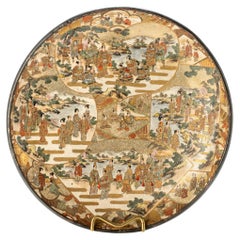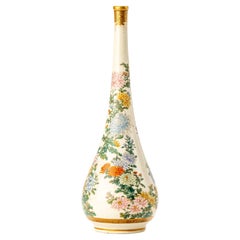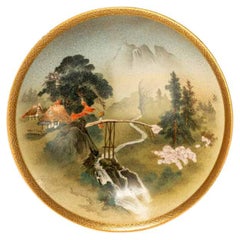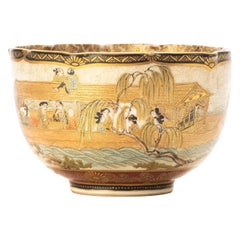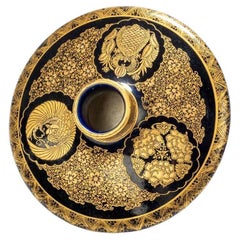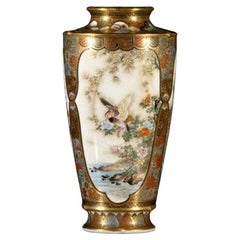Milan - Ceramics
11
11
1
to
2,010
1,434
23
12
12
1
1
7
3
12
2
1
1
23
3
1
12
12
10
10
10
Item Ships From: Milan
Satsuma ceramic plate adorned with polychrome and gold decorations
Located in Milano, IT
Satsuma ceramic plate adorned with polychrome and gold decorations within numerous reserves of unique shape and size, depicting scenes of Japanese daily life.
The plate is signed un...
Category
Late 19th Century Japanese Japonisme Antique Milan - Ceramics
Materials
Ceramic
A Satsuma vase decorated with a garden of chrysanthemums
Located in Milano, IT
Satsuma vase, with slender neck and terminal part adorned in pure gold decorated with a garden of chrysanthemums, made with enamel and gold in relief.
Different varieties of chrysan...
Category
Late 19th Century Japanese Japonisme Antique Milan - Ceramics
Materials
Ceramic
A Satsuma bowl decorated with a striking landscape
Located in Milano, IT
Satsuma bowl decorated with a striking landscape that evokes the beauty and serenity of the Japanese hills, with a gently flowing river surrounded by trees and mountains.
The bowl i...
Category
19th Century Japanese Japonisme Antique Milan - Ceramics
Materials
Ceramic
Satsuma ceramic lobed bowl, signed Juzan under the base
Located in Milano, IT
Satsuma ceramic lobed bowl adorned with raised enamels and fine gold details, depicting a vibrant landscape within. Characters and traditional Japanese home...
Category
Late 19th Century Japonisme Antique Milan - Ceramics
Materials
Ceramic
A Japanese Satsuma ceramic lobed bowl
Located in Milano, IT
Satsuma ceramic lobed bowl with curved corners and embellished with a refined scene of daily life along a watercourse on the outside. The interior is adorne...
Category
Late 19th Century Japanese Japonisme Antique Milan - Ceramics
Materials
Ceramic
A Japanese Satsuma ceramic bowl adorned with relief glazes and gold details
Located in Milano, IT
Satsuma ceramic bowl adorned with relief glazes and gold details depicting a motif of Manchurian Cranes in flight, symbols of longevity and happiness in Japanese culture.
Inside, the bowl features a dense motif of a thousand butterflies...
Category
Late 19th Century Japanese Japonisme Antique Milan - Ceramics
Materials
Ceramic
Italian modern skyscraper white beige Biscuit ceramic sculpture, 1980s
Located in MIlano, IT
Italian modern skyscraper white beige Biscuit ceramic sculpture, 1980s
Sculpture with rectangular base in Biscuit ceramic. The sculpture represents a skyscraper, on one side there is...
Category
1980s Italian Modern Vintage Milan - Ceramics
Materials
Ceramic
Cf Te12 Terre by Caturegli Formica
Located in Geneve, CH
CF Te12 Terre by Caturegli Formica
Dimensions: W 30 x D 30 H 14 cm
Materials: Ceramic
Terres, Dakar, Senegal, 1987-1991
TERRES is a series of symbolic ceramics sculpures pro...
Category
2010s Italian Post-Modern Milan - Ceramics
Materials
Ceramic
Cf Te18 Terre by Caturegli Formica
Located in Geneve, CH
CF Te18 Terre by Caturegli Formica
Dimensions: W 45 x H 48 cm
Materials: Ceramic
Terres, Dakar, Senegal, 1987-1991
TERRES is a series of symbolic ceramics sculpures produced...
Category
2010s Italian Post-Modern Milan - Ceramics
Materials
Ceramic
CF Te19 Terre by Caturegli Formica
Located in Geneve, CH
CF Te19 Terre by Caturegli Formica
Dimensions: W 45 x H 56 cm
Materials: Ceramic
Terres, Dakar, Senegal, 1987-1991
TERRES is a series of symbolic ceramics sculpures produced...
Category
2010s Italian Post-Modern Milan - Ceramics
Materials
Ceramic
Cf Te1.10 Terre by Caturegli Formica
Located in Geneve, CH
CF Te1.10 Terre by Caturegli Formica
Dimensions: W 45 x H 52 cm
Materials: Ceramic
Terres, Dakar, Senegal, 1987-1991
TERRES is a series of symbolic ceramics sculpures produc...
Category
2010s Italian Post-Modern Milan - Ceramics
Materials
Ceramic
CF Te1.11 Terre by Caturegli Formica
Located in Geneve, CH
CF Te1.11 Terre by Caturegli Formica
Dimensions: W 45 x H 54 cm
Materials: Ceramic
Terres, Dakar, Senegal, 1987-1991
TERRES is a series of symbolic ceramics sculpures produc...
Category
2010s Italian Post-Modern Milan - Ceramics
Materials
Ceramic
Cf Te13 Terre by Caturegli Formica
Located in Geneve, CH
CF Te13 Terre by Caturegli Formica
Dimensions: W 45 x H 49 cm
Materials: Ceramic
Terres, Dakar, Senegal, 1987-1991
TERRES is a series of symbolic ceramics sculpures produced...
Category
2010s Italian Post-Modern Milan - Ceramics
Materials
Ceramic
Cf Te2.1 Terre by Caturegli Formica
Located in Geneve, CH
CF Te2.1 Terre by Caturegli Formica
Dimensions: W 45 x H 65 cm
Materials: Ceramic
Terres, Dakar, Senegal, 1987-1991
TERRES is a series of symbolic ceramics sculpures produce...
Category
2010s Italian Post-Modern Milan - Ceramics
Materials
Ceramic
CF Te17 Terre by Caturegli Formica
Located in Geneve, CH
CF Te17 Terre by Caturegli Formica
Dimensions: W 45 x H 50 cm
Materials: Ceramic
Terres, Dakar, Senegal, 1987-1991
TERRES is a series of symbolic ceramics sculpures produced...
Category
2010s Italian Post-Modern Milan - Ceramics
Materials
Ceramic
CF Te2.6 Terre by Caturegli Formica
Located in Geneve, CH
CF Te2.6 Terre by Caturegli Formica
Dimensions: W 45 x H 55 cm
Materials: Ceramic
Terres, Dakar, Senegal, 1987-1991
TERRES is a series of symbolic ceramics sculpures produce...
Category
2010s Italian Post-Modern Milan - Ceramics
Materials
Ceramic
CF Te1.12 Terre by Caturegli Formica
Located in Geneve, CH
CF Te1.12 Terre by Caturegli Formica
Dimensions: W 45 x H 64 cm
Materials: Ceramic
Terres, Dakar, Senegal, 1987-1991
TERRES is a series of symbolic ceramics sculpures produc...
Category
2010s Italian Post-Modern Milan - Ceramics
Materials
Ceramic
CF Te16 Terre by Caturegli Formica
Located in Geneve, CH
CF Te16 Terre by Caturegli Formica
Dimensions: W 45 x H 36 cm
Materials: Ceramic
Terres, Dakar, Senegal, 1987-1991
TERRES is a series of symbolic ceramics sculpures produced...
Category
2010s Italian Post-Modern Milan - Ceramics
Materials
Ceramic
Porcelain Teapot, Milk Jug and Sugar Bowl, Birds and Flowers Japan Early 1900s
Located in Milan, IT
Polychrome hand-decorated porcelain teapot, milk jug and sugar bowl with refined depictions of birds, flowers, and bucolic Japanese landscapes....
Category
Early 20th Century Japanese Milan - Ceramics
Materials
Porcelain
Early 1900s Pair Antiques Japanese Porcelain Vases with Flowers and Butterflies
Located in Milan, IT
Pair of vases made of polychrome porcelain depicting hand-decorated flowers and butterflies, complete with base of carved wood. Japanese manufacture, early 1900s, signed on the base....
Category
Early 20th Century Japanese Milan - Ceramics
Materials
Porcelain, Wood
Late 17th Early 18th Century Nabeshima Japanese Porcelain Plate Fruit Design
Located in Milano, IT
Dish with karatuuri (melon) design
Late 17th-early 18th century
Porcelain decorated with cobalt blu underglaze and red fruits
Diameter 15.2 cm
Nabeshima ware was made at Okawachi near Arita in Kyushu under the authority of the Nabeshima clan. The feudal lords of Nabeshima were so proud of their technological skill, that throughout the Edo period (1615-1867) they gave porcelain (and swords) as presents to the lords of other provinces.
Most of Nabeshima porcelain...
Category
Late 17th Century Japanese Antique Milan - Ceramics
Materials
Porcelain
Shunichi Yabe Kofu #3, Wind of Light, Bizen Stoneware, 2013
Located in Milano, IT
What is immediately striking about the work of Yabe is his keen and natural sense of line. The artist, in fact, takes great care in first drawing an image of the work, and after hand-building the basic form a blend of Bizen mountain and rice-paddy clays, the work is carved with a knife into the form he had envisioned. After carving, the work is first bisque-fired and then its main-firing is executed in a small wood kiln for 3 days at a temperature reaching 1180 degrees. The resulting futuristic forms of Yabe’s stoneware present fresh new possibilities for Japanese Bizen clay in the 21st century.
Shunichi Yabe...
Category
21st Century and Contemporary Japanese Milan - Ceramics
Materials
Ceramic
Ceramic Tea Bowl 'Chawan', by Kamisaka Sekka
Located in Milano, IT
A ceramic tea bowl decorated with autumn grasses with signed and sealed tomobako.
Painter and designer, Kamisaka Sekka (Japan, 1866-1942) has been one ...
Category
19th Century Japanese Antique Milan - Ceramics
Materials
Ceramic
Related Items
Antique ca 1900 Japanese Satsuma Vase Richly Decorated Marked Miniature
Located in Amsterdam, Noord Holland
Description
A Japanese Satsuma teapot and cover marked base, miniature
Condition
Overall condition restoration to rim. Size 60mm high
Period
19...
Category
19th Century Japanese Meiji Antique Milan - Ceramics
Materials
Porcelain
Exceptional Large Satsuma Vase with Cover
Located in New York, NY
Exceptional and large Satsuma vase with cover with foo dog finial, finely enameled and gilt. Drilled apparently for use previously as table lamp. Firing crack to the lid, otherwise...
Category
1880s Antique Milan - Ceramics
Materials
Ceramic
Magnificent Antique Japanese Satsuma Vase, Meiji Era, Signed
Located in London, GB
A fine antique Japanese Satsuma vase.
Meiji period. Signed.
A very nice 19th century Japanese Satsuma ware vase of a relatively ...
Category
Late 19th Century Japanese Antique Milan - Ceramics
Materials
Ceramic, Porcelain
Japanese Meiji Period Satsuma Bowl Signed Suizan
Located in Newark, England
Japanese Meiji period satsuma scalloped shaped bowl. The bowl of beautiful form with gilt pin-striping and dotting to the accented areas. The exterior decorated with multiple fish swimming around the outside with small flower sprays between. To the inside a painted netting covers the bowl with butterflies and further floral sprays. The centre decorated with representations of each of the woodcut prints from Hiroshige's Tokaido gojusan tsugi (53 Stations of the Tokaido Road). To the base a stylised cartouche signature within an oval for Suizan.
This Japanese satsuma bowl...
Category
Late 19th Century Japanese Meiji Antique Milan - Ceramics
Materials
Ceramic, Earthenware, Pottery
Japanese Satsuma Vases, Pair
By Satsuma
Located in New York, NY
A gorgeous pair of Japanese earthenware Satsuma vases, hand-painted, Meiji period, circa early-20th century, Japan. Vases' beautiful decoration is high-qu...
Category
Early 20th Century Japanese Meiji Milan - Ceramics
Materials
Earthenware
Small Japanese Millefleur Satsuma bowl with Shimazu crest
Located in Hamburg, DE
A round bowl decorated with various flowers, colorful chrysanthemum-filled ground emulating the Chinese style of porcelain known as mille fleur. Each leaf and detail with a fine gold...
Category
Early 20th Century Japanese Taisho Milan - Ceramics
Materials
Ceramic
Antique ca 1900 Japanese Satsuma vase Richly Decorated Marked
Located in Amsterdam, Noord Holland
Description
A Japanese Satsuma vase and cover marked base
Condition
Overall Condition: 1 restuck chip to rim. Size 190mm high
Period
19th century Meiji Periode (1867-1912).
Category
19th Century Japanese Meiji Antique Milan - Ceramics
Materials
Porcelain
Japanese Satsuma Natsume Kinkozan
By Kinkozan
Located in Newark, England
Cobalt Blue Natsume
From our Japanese collection, we are delighted to offer this Japanese Satsuma Natsume by Kinkozan. The Natsume of elongated rectangular form with four recessed panels each bordered by a gilt foliage decoration. The Natsume raised upon a square base with a scalloped centre. The top of the Satsuma finished with the original lid with matching gilt foliage decoration. The panels of the Satsuma decorated with multiple figures in various pursuits framed within a shaped recesses. The base of the Satsuma is signed with the Kinkozan mark. The Natsume dates to the Meiji Period (1868-1912) circa 1890.
Natsume is a Chaki 茶器 (tea implement) used in a Japanese Tea Ceremony and is a term for a Japanese Tea Caddy...
Category
Late 19th Century Japanese Meiji Antique Milan - Ceramics
Materials
Enamel
Satsuma Vase Shimazu Clan
Located in Fulton, CA
Showa period Satsuma vase with Shimazu Clan marking. Japan, mid to late 20th century. Excellent original condition.
Category
20th Century Japanese Milan - Ceramics
Materials
Ceramic
Japanese Signed Polychrome Ceramic Pottery Plate, Showa Period
Located in Studio City, CA
A wonderfully decorated, hand painted Japanese plate.
From a collection of Japanese art, pottery, and artifacts.
Signed or stamped o...
Category
Mid-20th Century Japanese Showa Milan - Ceramics
Materials
Ceramic
A Fine Pair of Japanese Kutani Vases. The Best of Kutani, Satsuma.Signed. Meiji
Located in London, GB
A Fine pair of Japanese Kutani Vases. Signed.
Meiji period.
A very nice pair of Japanese Meiji Period (1867-1912) baluster shaped Kutani vases decorated with images of japanese ...
Category
Late 19th Century Japanese Antique Milan - Ceramics
Materials
Ceramic, Porcelain
H 3.35 in W 1.78 in D 3.35 in
Exquisite Hand Painted Japanese Satsuma Lidded Bowl
Located in San Francisco, CA
Exquisite Hand Painted Japanese Satsuma Lidded Bowl
A stunning lidded Japanese Satsuma bowl, likely Meiji period, completely hand painted inside and out. This could be used on your ...
Category
Mid-20th Century Japanese Anglo-Japanese Milan - Ceramics
Materials
Porcelain
Previously Available Items
A Satsuma vase with a cobalt blue background with fine golden details
Located in Milano, IT
Satsuma ceramic vase with disc shape, with a cobalt blue background enriched with fine golden details and reserves that house the three mons.
Signed Kinkozan under the base, inside ...
Category
19th Century Japanese Japonisme Antique Milan - Ceramics
Materials
Ceramic
A Japanese Satsuma vase characterized by three oval reserves, signed by Ryozan
Located in Milano, IT
A Satsuma vase characterized by three oval reserves adorned with naturalistic representations. One of the reserves depicts a flying bird among flowers, above a striking rocky water passage.
Scenes of daily life and landscapes are portrayed in the other reserves. In one of them you can admire geishas, samurais, and carako beneath a majestic blooming cherry tree. While in the other one, there is a characteristic Japanese house overlooking a picturesque watercourse. These compositions evoke a sense of harmony between humans and nature, capturing traditional Japanese aesthetics.
The sides of the reserves are decorated with gold, which assumes pastel tones ranging from green to red and harmoniously blends with the floral motifs. In this satsuma vase the quality and decorative perfection of the applied gold are excellent.
Signed by Ryozan Yasuda Company
Ryozan is a renowned brand in Japanese ceramic art, which gives this piece added value in terms of authenticity and craftsmanship. The craftsmanship of this company’s artisans is evident in every detail, from the precision of the lines to the vivid colors used. The vase represents an authentic work of art that embodies the rich artistic tradition of Japan. Its generous size and the beauty of its decoration make it not only a piece of historical and artistic value, but also a fascinating testament to Japanese culture.
The signature of Ryozan Yasuda Company further adds value and authenticity to this extraordinary work of art. Its name is synonymous with quality and craftsmanship in Japanese ceramic art, and this Satsuma vase is a tangible witness to that legacy. The combination of naturalistic elements and scenes of everyday life in this work truly captures the unique soul and aesthetic of Japan.
In conclusion, this Satsuma vase is more than just a work of art. It is a treasure that tells stories, captures emotions, and celebrates the beauty of Japanese nature...
Category
Late 19th Century Japanese Japonisme Antique Milan - Ceramics
Materials
Ceramic
A Japanese Satsuma plate depicting a Phoenix 鳳凰, signed Satsuma-yaki Shōzan ga
Located in Milano, IT
Large ceramic plate from Satsuma depicting a Phoenix 鳳凰 about to take flight with wings spread wide and long feathers fluttering finely decorated with gold and relief glazes.
Signed...
Category
Late 19th Century Japanese Japonisme Antique Milan - Ceramics
Materials
Ceramic
Pair of Japanese Ceramic Satsuma Vases with geishas and monks, 1875 circa
Located in Milan, IT
Pair of Satsuma vases made of finely hand-decorated ceramic depicting scenes with geishas and scenes with monks, dragon-shaped handles. Japan, last quarter of the 19th century. On th...
Category
Late 19th Century Japanese Antique Milan - Ceramics
Materials
Ceramic
Japanese Ko-Bizen Water Jar ‘Mizusashi’ Named “Matsugane”, 16th Century
Located in Milano, IT
This powerful mizusashi is characterized by the strong asymmetrical decoration; it exudes a raw energy that is inescapable, naturally drawing viewers in closer to ponder the dynamics of its creation. The body is naturally ash-glazed (shizen-yu) on one side, while the rest is left in plain clay with some light effects of koge (burn area) and hidasuki (reddish marks obtained burning straw on the clay). The glazed side, the one to be shown to guests during the tea ceremony, is decorated with a unique pattern as a result of a natural glazing caused by the ashes in the kiln: as more wood is burned, ash builds up to the face of the pot and fuses with the clay body, creating a glaze with stunning effects. The intense and nervous pattern has inspired the name Matsugane (Pine root), inscribed in red lacquer on the mizusashi by Gengensai (1810-77), 11th master and prominent figure in the Urasenke school, and Japanese tea ceremony history altogether. Gengensai also inscribed and signed the mizusashi’s box together with his pupil Somi Fukatsu, while another box is signed by Hounsai (born 1923), 15th master of the school. The interior is richly decorated in hidasuki.
The mizusashi is the largest utensil of Japanese tea ceremony; it contains the fresh water used to prepare the tea and to wash the tea-bowl and the bamboo tools. During the Muromachi period (1336-1573) Chinese vessels were used for this task but at the beginning of the Momoyama period (1573-1615), Bizen and Shigaraki wares were already more popular. The production of Bizen pottery (Bizen-yaki) started by the late Kamakura period (13th-14th century), taking its name after the place where it was made, Inbe, in Bizen province (now Okayama prefecture). Bizen-yaki ceramics are recognizable by their almost metallic hardness and their red-brownish color. The natural glazed effect and the eventual markings on the surface are consequences of the action of ashes during the firing process in the kilns; the result is an impressive variety of wares, each with different shape and surface effects.
This Ko-Bizen mizusashi reflects the taste of wabi-sabi Japanese aesthetics. Its beauty is discreet and derives from its natural imperfection. Shin’ichi...
Category
16th Century Japanese Antique Milan - Ceramics
Materials
Ceramic
Japanese Stoneware Oribe Serving Dish, 17th Century
Located in Milano, IT
With a tactile surface texture decorated with an asymmetrical design painted between green-glazed areas, this dish is a typical example of Green Oribe (ao-oribe) ware. The glaze fire...
Category
17th Century Japanese Antique Milan - Ceramics
Materials
Ceramic
Recently Viewed
View AllMore Ways To Browse
Foo Dog Art
Kangxi Qing Chinese
Ming Blue Porcelain
Japanese Porcelain 17th Century
Edo Japanese Blue
Qing Dynasty Green
Asian Art Foo Dogs
Asian Vases With Covers
Chinese Qing Bowl
Chinese Bats
Japan Incense
Iron Red Chinese Porcelain
Porcelain Ware Japanese
Pair Large Asian Vase
Ming Dynasty Ceramics
Song Dynasty Furniture
Insects China
Antique Arita Porcelain
